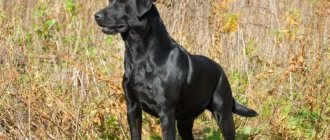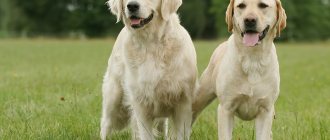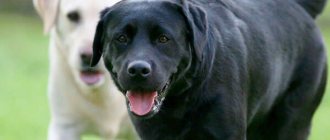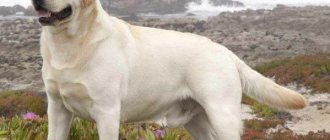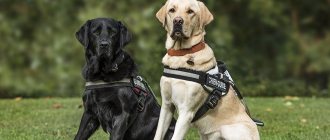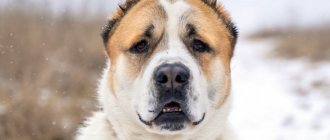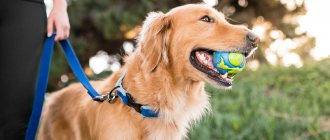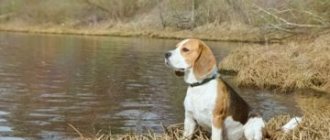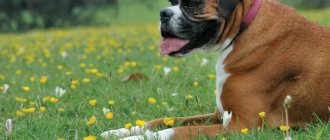The Labrador Retriever is a medium-sized dog, strongly built, with a broad head and broad chest. A characteristic feature of the breed is the shape of the tail, which continues the line of the back. It is thick at the base and gradually tapers towards the end. The coat is short, dense, hard, without curling. Underneath there is a thick, waterproof down. The ears are medium-sized, set far back, tightly pressed to the head. The paws have webs between the toes.
The ideal height at the withers is 56-57 cm for males, 54-56 cm for females. Permissible weight - 27-40 kg. The coat color can be coal black, fawn, or chocolate. One mother sometimes gives birth to puppies of all three colors.
Origin story
The history of the origin of Labrador retrievers is still hotly debated. According to one common theory, these dogs come from the Canadian island of Newfoundland. Their ancestors helped fishermen retrieve nets from the sea and were distinguished by their small size. These dogs were called small Newfoundlands. In the 19th century, several individuals were brought to England, where they were crossed with the Curly-Coated Retriever, Setter and English Foxhound. The result was Labradors.
There are three versions of the origin of the name. One of them concerns the color of the coat: the first Labradors were colored black, which gave them a resemblance to the labradorite rock. The second is related to the possible place of origin - the island of the same name. The third alludes to the working qualities of the dogs: the Portuguese appreciated their hard work and nicknamed them Labradors, which translates from Portuguese as hard worker.
The first version of the description of the breed was published in 1887.
Description of the breed
The Labrador is a large, well-built dog with a wide chest. She stands out for her prominent muscles and correct proportions.
Breed standard:
- Dimensions: height at withers up to 57 cm, weight up to 40 kg.
- The skull is massive, wide with a pronounced transition from the forehead to the muzzle. The muzzle is heavy and large. The jaws are well developed, with a strong grip, but at the same time soft. Scissor bite.
- Medium-sized eyes with brown or hazel irises.
- The ears are hanging, quite light, far and low set. Fit tightly to the head.
- The neck is strong, dry and muscular.
- The loin is straight, short, strong.
- The chest is wide, set deep.
- The tail, very thick at the base, gently tapers towards the bottom. Medium length, without dewlap, covered with short, abundant hair.
- The limbs are strong and straight. The paws are round and neat. The pads are thick and well developed.
Thanks to this build, the movements of the Labrador are free and direct.
Mini Labrador
In addition to dogs with generally accepted parameters, there are mini-copies of them, whose height is 40-42 cm. Such Labradors are the result of inbreeding or mating with a carrier of the dwarfism gene. They are not recognized by any official organization and are considered a marriage.
Dwarfism is a genetic abnormality, so you need to weigh the pros and cons before purchasing a mini Labrador. Unnaturally short stature is associated with a whole bunch of genetic abnormalities. This means that the dog will have to be examined regularly.
Colors and coat
Canadians' fur is thick and dense. It is moisture resistant and retains heat well. The guard hair is short and hard, the undercoat is abundant and dense. According to the standard, the Labrador is a smooth-haired dog, so wavy hair is considered a deviation.
Colors:
- black;
- brown;
- chocolate;
- pale yellow.
Golden, white, and fox-red are some of the common colors, but are outside the standard. White is acceptable as a marking on the chest (in dogs colored black or brown).
Use of Labrador in service dog breeding
- Since the breed was bred for hunting, the dogs are happy to bring killed ducks. Able to swim behind them in cold water. This is definitely a plus for hunters. On the other hand, the owner who keeps a Labrador in a small apartment will not like the dog looking for any mud or puddle to plunge into. Because he loves to swim.
- Since Labradors are smart and have a good sense of smell , they are used to search for people in the Ministry of Emergency Situations and the police.
- At customs, dogs successfully cope with the search for drugs and explosives.
- Labradors are the best friends for sick children. Helps to adapt to society. For example, they are indispensable for children with autism or Down's disease.
- Retrievers are trained as guide dogs for visually impaired people. Since they are flexible, intelligent and friendly, they successfully cope with their task.
- Since Labradors have a strong build, they can work in a harness (if necessary).
Character
Labradors are balanced and easy to train dogs. They are known for their fantastic sense of smell and love for fetching. This allows them to work in customs services, perform the duties of guides and rescuers. Canadians have traditionally been used as draft and hunting dogs.
Labrador retrievers have millions of fans. They make excellent companions and nannies for children. These are friendly, gentle creatures. Canadians consider the owner to be the center of the universe and love to participate in family affairs. At the same time, these are sensitive, unobtrusive dogs that know when their company is unwelcome.
Labradors have a hard time with loneliness. If they are often left alone, they begin to spoil their owner's things and bark monotonously for a long time. There have been cases when dogs left home where they felt unwanted.
Labradors love children very much. They are not irritated by screams, noise, bustle and violent manifestations of love. Canadians love spending time with people, so their age doesn't matter. Labradors themselves remain children until they are 3 years old. Slow maturation is reflected in persistent enthusiasm and desire to play. This breed needs constant activity. If a dog is bored, it will entertain itself on its own, which can have a negative impact on the condition of the home.
Canadians are not prone to zoo aggression and get along easily with cats and dogs. Birds are an exception to the general picture. Labradors will not be able to suppress the instincts of the hunter, which means the bird will be in danger. The upbringing and socialization of Labradors begins at an early age. Canadians strive to earn the owner's approval and quickly remember commands.
Labrador is not suitable for home protection: it has no tendency to aggression. Dogs are friendly by nature and will be happy to meet anyone.
Retriever in the service of a person
Initially, Labradors were used for fishing, then for hunting, as carriers of game. Due to their excessive kindness, they are completely unsuitable for security guard duty. But, given the characteristics of the breed, they are able to cope with various other tasks. Quick learning, precise execution of commands, friendliness, and quick wit (see “Labrador Retriever: Characteristics”) make them excellent therapy dogs for elderly and disabled people, and guide dogs for the blind and visually impaired.
Since retrievers are fearless, quickly get to work, and have an excellent sense of smell, they take part in rescue operations after avalanches, earthquakes and other disasters. Many Labradors serve at customs, in the emergency services of the Ministry of Emergency Situations, units of special forces, and the police. After special training, animals are able to detect explosive devices, narcotic and explosive substances, weapons, and ammunition by smell. Thanks to their thick coat, patience, and endurance, they work in difficult weather conditions.
Care and maintenance
Canadians can be kept in a private house or apartment. They have long adapted to the conditions of the city, because the main thing for them is communication with the owner. A Labrador can be kept in an outdoor enclosure. It should be spacious and located so that the dog has a clear view of the yard. A Labrador can live outside in winter if there is an insulated box. Booth dimensions: 160//95/95. An enclosure for a Labrador must have an area of at least 8 square meters and a floor with a warm covering.
Keeping a Labrador outdoors is a bad idea. Canadians adore their owners and want to be part of the family. Dogs living in the yard become nervous and excitable. In addition, there is no practical use: Labradorite is a terrible guard.
Canadians shed all year round. During the seasonal molting season, wool falls out profusely. The dog is combed every 2 days to remove as much dead hair as possible. When a Labrador sheds heavily, it is combed with a furminator. If the hair does not decrease, the dog should be shown to a veterinarian. The reason may be hormonal problems and deficiency of nutrients. To stimulate coat change, it is recommended to wash the dog in warm water.
This breed does not need a haircut. Including show dogs. Canadians do not need to bathe frequently. 3 procedures per year are enough. In case of minor contamination, the dog is rinsed with water (without detergents).
Special dog cosmetics are used for washing! Labradors are not suitable for human shampoos. They wash away the protective fat layer from the skin, causing irritation and dandruff.
Canadian ears require careful care. Closing the ears contributes to the development of infection. Therefore, they need to be regularly inspected and wiped with a cotton pad soaked in warm water. You can use a special lotion. It is strictly forbidden to clean your ears with cotton swabs: they can easily cause injury.
It is important to take good care of your eyes. They are wiped with a cotton swab dipped in warm water or chamomile decoction. Cleaning movements should be directed towards the corner of the eye. Teeth are brushed weekly. The ideal option is every day. Nails are trimmed twice a month.
Feeding
Canadians can be fed high-quality dry food or home-cooked meals. The choice depends on the preferences of the owner. Modern dry food is made from natural meat and vegetables. They do not harm the dog’s body and contain essential vitamins.
If the owner decides to feed the dog natural food, he must include the following products in the menu:
- dietary meat (beef, lamb, poultry);
- boiled offal (tripe is especially useful);
- cartilage (very moderate);
- boiled sea fish (a couple of pieces per week);
- buckwheat and rice;
- cottage cheese, kefir, yogurt;
- boiled eggs (2 eggs per week);
- carrots, cabbage, zucchini, pumpkin;
- greenery;
- seasonal fruits.
The daily portion consists of 50% meat, 25% cereals and 25% vegetables. An adult dog needs to be fed 2 times a day. The meat is given raw, scalded with boiling water or boiled. The optimal amount is 15 g per kg of weight. The head, tail, fins, bones and entrails are removed from the fish. It is better to boil it until tender. If a dog loves raw fish, it is necessary to give it anthelmintic drugs as a preventative measure.
River fish is boiled before serving: it contains worm eggs.
List of prohibited products:
- high-calorie meat (pork);
- river fish (undesirable);
- milk (poorly absorbed by the body of an adult dog);
- poultry tubular bones;
- potato;
- legumes;
- confectionery and sausages;
- fresh bread and products made from yeast flour;
- sauces;
- roast;
- fat;
- smoked;
- salty;
- spicy;
- seasonings and spices.
Eating natural foods should be accompanied by taking a vitamin complex. It is prescribed by a veterinarian.
If the owner decides to feed his Labrador dry food, super premium food will suit him. Premium food is made from by-products and fillers that cause allergies. Despite the name, it is not much different from economy class products. These products have a poor composition and provoke stomach upsets, allergies and urolithiasis.
List of quality feeds:
- Akana;
- Nutra Gold;
- Bosch;
- Fest Choice;
- Pronature;
- Go!;
- Naw!;
- Orijen;
- Grandorf;
- Innova;
- Hills.
Recommendations for the volume of daily servings can be found directly on the packaging or the manufacturer’s official website.
Canadians have problems with excess weight, so do not exceed the recommended serving size.
The animal must have constant access to fresh water. This applies to any type of feeding.
What to feed a puppy
Puppies can grow up both dry and natural. Dry food is introduced at 1.5 months. The main thing is to soak the granules.
The menu based on natural products includes:
- beef, poultry, lamb and horse meat;
- boiled offal (liver, heart, kidneys, stomach and udder);
- sea fish;
- buckwheat, millet, rice cereals;
- milk, cottage cheese, kefir, yogurt;
- raw yolk (along with cereals);
- boiled eggs or omelet (no more than 2 times a week);
- carrots, zucchini, pumpkin, cabbage, beets and rutabaga;
- parsley, dill, lettuce, onion feathers;
- 1 clove of garlic per week.
The list of prohibited foods is the same as the list for adult dogs.
The puppy should be fed according to the following regimen:
- at 2-4 months – 5 times a day;
- at 3-6 months – 4 times a day;
- at 6-10 months – 3 times a day;
- at 10 months and beyond - 2 times a day.
The daily meat requirement for a growing Labrador is 45 g per 1 kg of weight.
Dry puppy food can be found in the list for adult dogs. The listed manufacturers produce lines for puppies. The optimal daily serving size is indicated on the packaging (it is calculated based on weight).
To monitor the puppy’s development, it is recommended to study the optimal weight of a Labrador by month:
| Age | Weight |
| 1 month | 3.4-3.8 kg |
| 2 months | 7-8 kg |
| 3 months | 12-14 kg |
| 4 months | 17-19 kg |
| 5 months | 21-22 kg |
| 6 months | 24-26 kg |
| 7 months | 26-28 kg |
| 8 months | 28-30 kg |
| 9 months | 29-32 kg |
| 10 months | 30-36 kg |
| Adult Labrador | 30-40 kg |
On average, Canadians take up to 10 months to grow. A serious discrepancy with the specified parameters is a reason to reconsider the dog’s diet or consult a doctor.
How to care for Labradors
Care will not be difficult. It is enough to brush your Labrador Retriever once a week to keep its coat looking beautiful and neat.
Labrador ears need to be cleaned with a special lotion. Usually, several such procedures per month or even less often are enough, it all depends on the degree of contamination. As for teeth, their condition also deserves attention.
Another important procedure is cutting the nails. They are shortened as they grow, and this can be done either independently or by specialists - in a veterinary clinic or grooming salon.
Experiment
